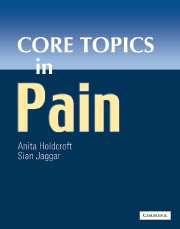Book contents
- Frontmatter
- Contents
- Contributors
- Preface
- Acknowledgements
- Foreword
- General abbreviations
- Basic science abbreviations
- PART 1 BASIC SCIENCE
- PART 2 PAIN ASSESSMENT
- Section 2a Pain measurement
- Section 2b Diagnostic strategies
- PART 3 PAIN IN THE CLINICAL SETTING
- Section 3a Clinical presentations
- Section 3b Pain syndromes
- PART 4 THE ROLE OF EVIDENCE IN PAIN MANAGEMENT
- PART 5 TREATMENT OF PAIN
- Section 5a General Principles
- Section 5b Physical treatments
- Section 5c Pharmacology
- 39 Routes, formulations and drug combinations
- 40 Opioids and codeine
- 41 Non-steroidal anti-inflammatory agents
- 42 Antidepressants, anticonvulsants, local anaesthetics, antiarrhythmics and calcium channel antagonists
- 43 Cannabinoids and other agents
- Section 5d Psychosocial
- PART 6 SUMMARIES
- Glossary
- Index
42 - Antidepressants, anticonvulsants, local anaesthetics, antiarrhythmics and calcium channel antagonists
from Section 5c - Pharmacology
Published online by Cambridge University Press: 10 December 2009
- Frontmatter
- Contents
- Contributors
- Preface
- Acknowledgements
- Foreword
- General abbreviations
- Basic science abbreviations
- PART 1 BASIC SCIENCE
- PART 2 PAIN ASSESSMENT
- Section 2a Pain measurement
- Section 2b Diagnostic strategies
- PART 3 PAIN IN THE CLINICAL SETTING
- Section 3a Clinical presentations
- Section 3b Pain syndromes
- PART 4 THE ROLE OF EVIDENCE IN PAIN MANAGEMENT
- PART 5 TREATMENT OF PAIN
- Section 5a General Principles
- Section 5b Physical treatments
- Section 5c Pharmacology
- 39 Routes, formulations and drug combinations
- 40 Opioids and codeine
- 41 Non-steroidal anti-inflammatory agents
- 42 Antidepressants, anticonvulsants, local anaesthetics, antiarrhythmics and calcium channel antagonists
- 43 Cannabinoids and other agents
- Section 5d Psychosocial
- PART 6 SUMMARIES
- Glossary
- Index
Summary
Introduction
A rapidly evolving understanding of the neurobiology of pain has:
Allowed development of novel compounds likely to modify the pain experience.
Provided a scientific rationale for the use of a number of classes of existing drugs in the treatment of pain.
Similarly, empirical observations regarding the efficacy of such drugs have illuminated some of the mechanisms involved in pain processing.
Pains associated with nervous system damage or dysfunction (neuropathic and central pain syndromes) are often refractory to conventional analgesic therapy. It is in this spectrum of disorders that (inappropriately so called) ‘non-analgesic’ drugs are most frequently used. The drugs used are chemically diverse compounds and many have a number of relevant actions in the treatment of pain. It is important to note that the published data on these drugs relate to their use in relatively few, specifically defined, pain conditions. In contrast, many patients present a mechanistically more complex picture. The use of these drugs in the more general pain population is, therefore, based on inferences drawn from specific studies augmented by clinical experience.
Antidepressant drugs
History
Tricyclic antidepressants were first synthesised in the 1940s and used for the treatment of depression a decade later. The drugs were subsequently shown to have analgesic properties both in patients with chronic pain-induced depression, and also in those with normal mood.
- Type
- Chapter
- Information
- Core Topics in Pain , pp. 281 - 286Publisher: Cambridge University PressPrint publication year: 2005



